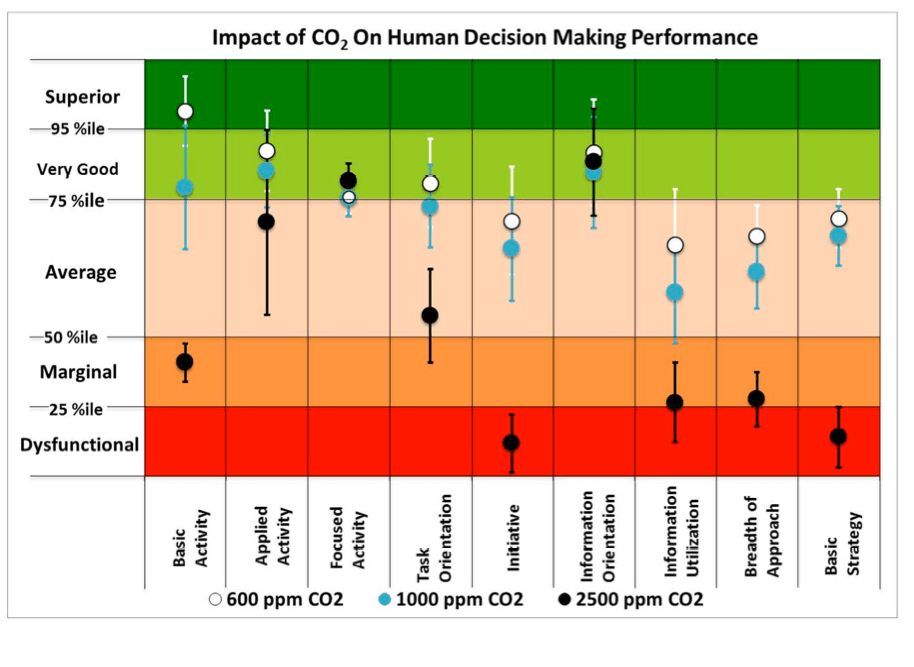Why We Should Measure Carbon Dioxide (CO2)?
Carbon dioxide is a natural constituent of the air we breathe. Humans breathe in oxygen and release carbon dioxide, plants breathe in carbon dioxide and release oxygen. So why lately, are we hearing so much about carbon dioxide as an air pollutant?
Before we talk about CO2 as pollutant or a health hazard, let’s dwell on Indoor Air Quality (IAQ). IAQ is a term coined to represent the air quality of occupied buildings, which can be offices, factories, showrooms, malls, schools, colleges & so on and so forth. Carbon dioxide is one of the most important gases affecting IAQ.
We measure CO2 in ppm which is parts per million. The global outdoor monthly average level of CO2 in June 2018 was 410ppm which is the highest in the past 8,000,000 years (Read more here). However in an enclosed indoor area the CO2 levels are significantly higher. Various studies show that healthy CO2 levels in an enclosed space should be less than 750ppm. However, on an average, a normal human being exhales about 35 to 50K ppm per day; and if there is inadequate ventilation then the exhaled CO2 accumulates. Let's take an example, in an enclosed space of 3.5m X 4m, with single occupancy, without any ventilation, CO2 will increase from 500ppm to 1000ppm in only 45mins. With more number of occupants for greater time, the results can be disastrous! This is why CO2 levels inside offices with over 200 employees on a floor, or schools with 40 children in a classroom or a car with 3 occupants, or even a bedroom with 3 people sleeping at night with no ventilation can quickly climb to as high as 4000-5000 ppm or more!
We might be very health conscious and closely track outdoor air pollution but unconsciously we are inhaling this pollutant in the comfort of our houses or offices. A study by the Harvard Chan School of Public Health finds that there is a direct and negative impact of CO2 on our cognition and decision making skills. They found that on an average, a typical participants' cognitive scores dropped 21% with a 400 ppm increase in CO2. As per the report “For seven of the nine cognitive function domains, average cognitive scores decreased at each higher level of CO2. Cognitive function scores were 15% lower for the moderate CO2 day (~945 ppm) and 50% lower on the day with CO2 concentrations around 1400 ppm” (Source : link)

Department of Energy’s Lawrence Berkeley National Laboratory (Berkeley Lab) also researched this topic and concluded that moderate to high level of CO2 in the air drastically reduces decision making skills of the occupants. “Relative to 600 ppm, at 1,000 ppm CO2, moderate and statistically significant decrements occurred in six of nine scales of decision-making performance. At 2,500 ppm, large and statistically significant reductions occurred in seven scales of decision-making performance.
Source: link
Prolonged inhalation of CO2 might result in fatigue, decrease in productivity, headaches and absenteeism. High levels of CO2 also indicate poor ventilation which can lead to increased humidity, as moisture produced indoors is not vented to the outside. High humidity can encourage the growth of mould and dust mites; both of which are allergens and asthma triggers.
In an office or school or any other commercial property, the central cooling system (or HVAC system which stands for Heating, ventilation, and air conditioning system) usually re-circulates a significant portion of the indoor air. This is done to reduce energy costs which would be required to cool the hot fresh air from outside. Most buildings do have fresh air units which pull fresh air into the buildings but these are not opened regularly and instead the same stale air is re-circulated thus significantly increasing CO2 levels inside the building over-time. This is why you catch yourself yawning and feeling sleepy as the day progresses.
The first step to fixing this is to start monitoring CO2 levels. Once we start measuring CO2 levels in buildings we can start ensuring that fresh air is brought in regularly to ensure CO2 levels are within thresholds. Various solutions like Demand Controlled Ventilation (DVC), monitor CO2 levels and automate ventilation to intake fresh air only when needed, helping reduce energy costs. Similarly energy recovery ventilators(ERV) can help recover more than upto 75% of latent energy from the stale exhaust air and transfer it to the fresh outside air coming into the building, thus reducing energy costs significantly. At home, something as simple as opening the windows to let some fresh air in, when CO2 levels become very high can solve the problem. For offices you must talk to your building manager and encourage them to monitor CO2 levels and ventilate the building regularly to ensure that CO2 levels are within limits. Similarly in your child's school talk to your school administration and ensure that they are ventilating the classrooms regularly to ensure optimal cognitive development for your child.
Are you measuring CO2 in your homes and offices and ensuring that it is not affecting your productivity and cognition drastically? If not, then start today.

